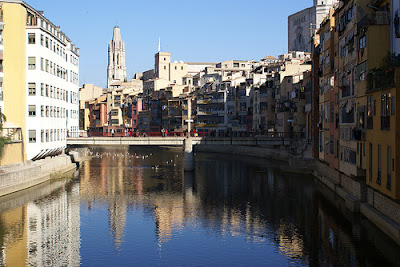


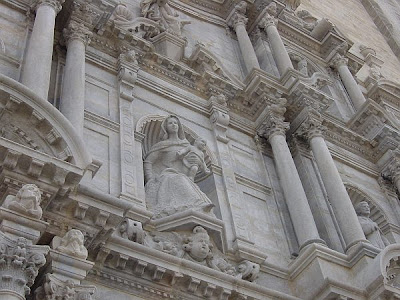



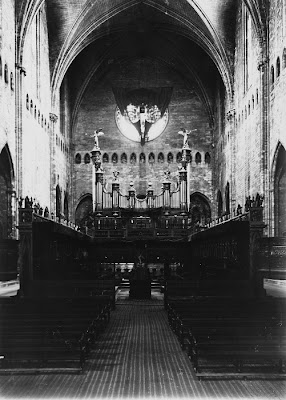
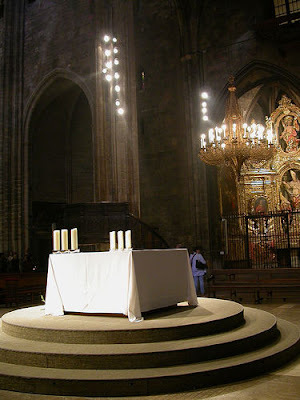
 FERNÁNDEZ, Pedro (b. ca. 1480, Murcia, d. after 1521)
FERNÁNDEZ, Pedro (b. ca. 1480, Murcia, d. after 1521)Retable of St Helen 1521
Oil on panel
Cathedral, Gerona
 Grave of Ramon Berenguer II, Cathedral of Girona
Grave of Ramon Berenguer II, Cathedral of Girona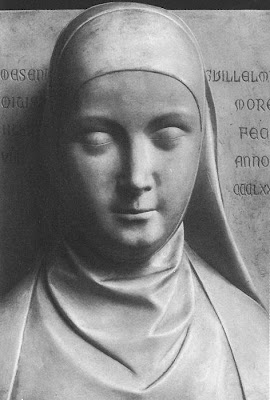 Monument to Count Ramón Berenguer II and his Wife Ermesindis (detail)
Monument to Count Ramón Berenguer II and his Wife Ermesindis (detail)The detail shows the head of Countess Ermesindis
The City of Gerona (Girona) is now one of the most accessible cities in Spain - thanks to Ryanair and similar cut price airlines. Ryanair, after all, has probably done more for European integration than the whole barrage of European regulations with which we have become so familiar.
Many overlook the city whilst on the way to the various Costas and Barcelona. However that would be a pity.
It is generally held that the See was erected in 247. On 18 June, 517, a synod was convened here, and attended by the Archbishop of Tarragona and six bishops.
The city has undergone twenty-five sieges and been captured seven times.
In the time of Charlemagne it was wrested temporarily from the Moors, who were driven out finally in 1015.
The ancient cathedral, which stood on the site of the present one, was used by the Moors as a mosque.
The present building is the result of superimposition and addition of different architectural styles, starting from the first known Romanesque building which was consecrated in 1038. The present edifice is one of the noblest monuments of the school of the Majorcan architect, Jayme Fabre, and one of the finest specimens of Gothic architecture in Spain. However there are also later constructions including Baroque.
It is approached by eighty-six steps. An aisle and chapels surround the choir, which opens by three arches into the nave, of which the pointed stone vault is the second widest in Christendom (73 feet) after St Peters Basilica in the Vatican. A single nave was an innovation in the 14th century, preferred for the better acoustics it gave. In this case, however, it had to match a wide choir, already built with a standard three-aisle nave in mind.
Among its interior decorations is the retable of St Helen (1521) which is the work of the Spanish painter, Pedro Fernández (b. ca. 1480, Murcia, d. after 1521). Until recently he was known to art historians as "Pseudo Bramantino". He was the first Spanish painter to demonstrate a grasp of the Italian Renaissance style. In the centre of the altarpiece, below a Crucifixion scene, stands the giant figure of St Helen. On the sides there are six scenes from the life of St Helen and Constantine. In the lunette the Virgin of Mercy is depicted, while the predella contains an Ecce Homo and four figures of saints.
The cathedral also contains the marble Funerary Monuments to Count Ramón Berenguer II and his Wife Ermesindis (1380-90), possibly by the Catalan sculptor, Guillermo Morey.
References:
For more on the history and images of the Cathedral exterior and interior and the various treasures relating to the Cathedral, see the Official web site at http://www.lacatedraldegirona.com
The City of Girona official website is also good for other sights in the City
See http://www.ajuntament.gi/web
Girona used to have a large Jewish population. For a history of the City from another perspective, see The Jewish Encyclopedia at http://www.jewishencyclopedia.com/view.jsp?artid=164&letter=G
Many overlook the city whilst on the way to the various Costas and Barcelona. However that would be a pity.
It is generally held that the See was erected in 247. On 18 June, 517, a synod was convened here, and attended by the Archbishop of Tarragona and six bishops.
The city has undergone twenty-five sieges and been captured seven times.
In the time of Charlemagne it was wrested temporarily from the Moors, who were driven out finally in 1015.
The ancient cathedral, which stood on the site of the present one, was used by the Moors as a mosque.
The present building is the result of superimposition and addition of different architectural styles, starting from the first known Romanesque building which was consecrated in 1038. The present edifice is one of the noblest monuments of the school of the Majorcan architect, Jayme Fabre, and one of the finest specimens of Gothic architecture in Spain. However there are also later constructions including Baroque.
It is approached by eighty-six steps. An aisle and chapels surround the choir, which opens by three arches into the nave, of which the pointed stone vault is the second widest in Christendom (73 feet) after St Peters Basilica in the Vatican. A single nave was an innovation in the 14th century, preferred for the better acoustics it gave. In this case, however, it had to match a wide choir, already built with a standard three-aisle nave in mind.
Among its interior decorations is the retable of St Helen (1521) which is the work of the Spanish painter, Pedro Fernández (b. ca. 1480, Murcia, d. after 1521). Until recently he was known to art historians as "Pseudo Bramantino". He was the first Spanish painter to demonstrate a grasp of the Italian Renaissance style. In the centre of the altarpiece, below a Crucifixion scene, stands the giant figure of St Helen. On the sides there are six scenes from the life of St Helen and Constantine. In the lunette the Virgin of Mercy is depicted, while the predella contains an Ecce Homo and four figures of saints.
The cathedral also contains the marble Funerary Monuments to Count Ramón Berenguer II and his Wife Ermesindis (1380-90), possibly by the Catalan sculptor, Guillermo Morey.
References:
For more on the history and images of the Cathedral exterior and interior and the various treasures relating to the Cathedral, see the Official web site at http://www.lacatedraldegirona.com
The City of Girona official website is also good for other sights in the City
See http://www.ajuntament.gi/web
Girona used to have a large Jewish population. For a history of the City from another perspective, see The Jewish Encyclopedia at http://www.jewishencyclopedia.com/view.jsp?artid=164&letter=G

No comments:
Post a Comment